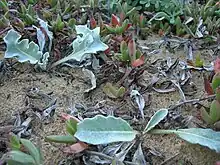| Cirsium rhothophilum | |
|---|---|
 | |
| Scientific classification | |
| Kingdom: | Plantae |
| Clade: | Tracheophytes |
| Clade: | Angiosperms |
| Clade: | Eudicots |
| Clade: | Asterids |
| Order: | Asterales |
| Family: | Asteraceae |
| Genus: | Cirsium |
| Species: | C. rhothophilum |
| Binomial name | |
| Cirsium rhothophilum | |
| Synonyms[1][2] | |
| |
Cirsium rhothophilum is a rare North American species of thistle known by the common name surf thistle. It is endemic to California, where it is known only from the coastline around the border between San Luis Obispo and Santa Barbara Counties. It grows in sand dunes and coastal scrub near the beach.[3]
Cirsium rhothophilum grows up to 100 cm (39 in) tall with fleshy, woolly herbage usually forming a mound. The thick leaves are wavy and covered in feltlike hairs. They may have smooth, lobed, or toothed edges and small spines. The largest leaves at the base of the plant may reach 25 centimetres (9.8 inches) in length. The inflorescence bears several clustered flower heads, each head up to 4 centimeters long and 6 cm wide. The heads are lined with woolly phyllaries and filled with off-white to pale yellowish disc florets but no ray florets. The fruit is an achene a few millimeters long with a pappus up to 2 centimeters in length.[4]
References
External links
- photo of herbarium specimen at Missouri Botanical Garden, collected in Santa Barbara County, isotype of Carduus maritima/Cirsium rhothophilum
- Jepson Manual Treatment
- Calphotos Photo gallery, University of California